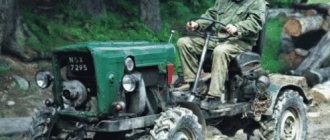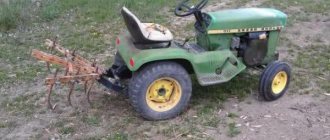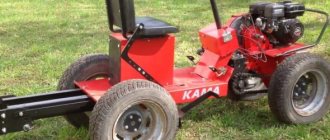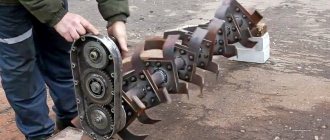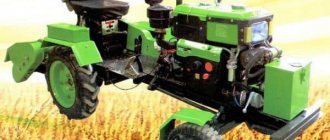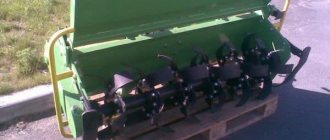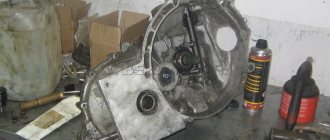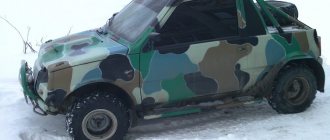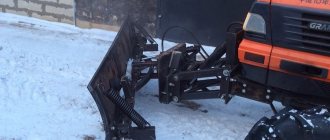Russia has a huge number of rivers, lakes and creeks. Some of them are shallow, others are overgrown with reeds, and there are hummocks and shallows at every step. In such conditions, fishermen and hunters would find an all-terrain boat motor very useful - a swamp rover.
Such an engine will cope with strong thickets and will not get tangled or break. Just a few centimeters of water under the bottom is enough to get into a difficult body of water. You can make a swamp rover for a boat with your own hands. This is a good option to save money, since ready-made equipment is expensive.
How to assemble a mini tractor with a gearbox and parts from ZAZ with your own hands
Many farmers want to know how to install a ZAZ gearbox on a mini tractor. Agricultural machinery is an irreplaceable thing, but its cost often deters farmers with small plots of land. It is believed that spending huge amounts of money on treating a small area is inappropriate. But do not forget that it is also impossible to completely replace the machine, performing all actions exclusively with your hands.
In this case, a homemade mini-tractor, designed on the basis of an old car, for example, a Zaporozhets, can come to the rescue. Despite the fact that the car body quickly breaks down, inside the car is equipped with powerful and high-quality elements necessary for the functioning of the vehicle.
What tools are needed for the job?
To independently assemble a propulsion device in wetlands, you will need the following tools:
- set of wrenches;
- files;
- welding machine;
- grinder with metal discs;
- metal brush;
- drill with metal drills.
If you don’t have a welding machine, you can connect individual parts using bolts.
Supplies you need to prepare:
- metal plate with a thickness of 4 mm;
- folding mechanism (book);
- bolts and nuts;
- fittings, metal corners;
- tubes, moving shaft, bearings;
- auger-type metal screw;
- cardan coupling;
- pipe for making a handle.
The key element is a gasoline propulsion unit from agricultural machinery or an old donor boat engine.
Is it possible to make a mini tractor based on a ZAZ gearbox?
That is why many spare parts, such as a gearbox or Zaporozhets engine, are perfect for making a mini tractor with your own hands.
Such a machine is useful for performing any small-scale agricultural work.
So, with its help you can plow the area more efficiently, cultivate the soil or form beds. A mini tractor based on the ZAZ gearbox is also suitable for winter work, including snow removal, for transporting garbage or harvested crops.
Thanks to modern technologies and the ability to find all the necessary drawings and diagrams, a mini tractor from Zaporozhets can be made by any farmer with minimal skills and the necessary available tools.
Wheels
First, you need to determine the tire sizes. Many people take tires from ZIL-131 or from Oka, in which the top of the wire cord is removed. One of the screws is cut through the cut window, the wire is removed around the entire perimeter. Then the sidewall from the cord to the tread is cut at a distance of about 8 cm. The fang is undermined and the edges are trimmed with a knife.
This is done clockwise, after which a tread is formed. A picture is placed on the camera, most often a Christmas tree is chosen, but you can deviate from this rule. The pattern is cut with a knife, the angle is trapezoidal.
After which you will need perseverance, since the peeling process is quite long. There is no need to rush, so as not to ruin all the work, making the work unsuitable for use.
Homemade swamp vehicles can be no worse than industrial ones, if all the nuances are taken into account correctly. When choosing a tread, you need to take into account that it must be self-cleaning, this is important when moving through wetlands.
On peat bogs, you should not choose too deep a terrain to avoid breaking through the surface and loss of adhesion. A rare pattern is selected for movement on sand and snow. Disks, as a rule, are standard. But many people prefer to attach additional “basins” to belts or transport tape.
How to make a mini tractor with a ZAZ engine
In order to make a mini tractor with a ZAZ 968 engine, you will need the following components:
- Front axle and rear axle. It is recommended to shorten them in advance and digest the parts. In this case, the front axle can be used directly in conjunction with existing rims. The tires on them should be changed if necessary.
- The brake, as well as a couple of sets of hubs, which are useful for the wheels located at the rear of the tractor.
- Clutch and steering box.
- ZAZ gearbox for a mini tractor, equipped with axle shafts. Of course, you can replace this structural element with another, more powerful one, since initially the gearbox models were not designed to work with strong traction. However, consider the case when everything is taken from the car.
- Hydraulic system. In some cases, some of the hoses and fittings need to be updated.
No difficulties should arise with the ZAZ engine and its crankshaft. Again, as with the gearbox, you can replace the unit with a more powerful power plant, but this is not always advisable.
The tractor cabin from Zaporozhets is constructed from several corners made of metal material and steel sheets. All these elements are welded and equipped with a standard driver’s seat, taken from the same Zaporozhets.
What are buds and what are they for?
Tires (also known as low-pressure tires) are huge tractor, truck or helicopter tires that have been stripped of excess rubber.
Thanks to the large area of such wheels and their low pressure on the surface, an ordinary passenger car equipped with them becomes a real SUV .
With encouragement, Niva and UAZ can overcome a wide variety of obstacles - fields, deserts, rocky and marshy soil.
It is difficult for hunters and simply those who like to ride in difficult terrain to do without wheels with low pressure.
Making such tires yourself is not a problem. For this, the most common tools like a knife or winch . It will still take a little skill.
Before you start creating low-pressure tires, you need to clearly understand what exactly they will be needed for , that is, in what conditions, where exactly they will be used.
If:
- primarily for driving on dirty, bumpy roads and rural roads - then you need to use a self-cleaning tread;
- If we go through swamps on tires, we will need to lower the tread grooves a little so that the grip becomes as good as possible;
- In snow drifts and sand, it is better to drive on tires on which the tread pattern elements are as close to each other as possible.
You need to think about the above in advance.
Assembling a homemade tractor from Zaporozhets
Buying agricultural machinery for small farms and cultivating small plots of land is not profitable.
However, manual labor will not fully replace agricultural machinery. Fortunately, a homemade tractor from Zaporozhets will be an adequate replacement for factory equipment. The tin body quickly becomes unusable. But the car is filled with high-quality and more powerful hardware than it might seem at first glance. Therefore, spare parts and components can be used to manufacture a functional compact tractor suitable for various agricultural work. From plowing and tilling soil to forming beds, mowing, removing snow and debris, transporting compact loads and crops.
Advantages and disadvantages
Wheels have many advantages over purchased wheels:
- Price. All-terrain wheels are very expensive, which can’t be said about the wheels.
- Such wheels have excellent adhesion to almost any surface, which significantly reduces the risk of accidents.
- The husks weigh relatively little. An “unpumped” passenger car engine will be quite capable of cranking them.
- Low surface pressure due to the large tire area. With encouragement, muddy terrain, quicksand and deep snow become quite passable obstacles. The tire pressure on the surface can be adjusted. They just need to be pumped up or lowered a little.
- Tires with low pressure do not harm the surface soil layers in any way, so you can safely drive an all-terrain vehicle with tires across plowed fields or use it as a tractor in agriculture.
They are also not without some disadvantages :
- You should try to ride less on hard asphalt and concrete surfaces. Otherwise, they will have to be changed very soon .
- A car on such wheels is not very stable. It’s better not to make sharp turns on it, and you shouldn’t drive it fast at all.
- Wheels wear out much faster than normal ones.
- Encouragement is a considerable burden. Transmission and suspension parts with such wheels will have to be changed and repaired more often.
- Low pressure tires are very flexible. This increases their permeability. But due to their increased stretchability, tires get punctured more often than regular tires.
- The car will have to be re-registered - “upgraded” to the status of an all-terrain vehicle.
How to make a tractor out of a Cossack for your own farm?
Thanks to the availability of information, drawings and diagrams, today it is possible to make a functional tractor using any available means. Including available spare parts from the familiar ZAZ car.
To construct a tractor with your own hands from Zaporozhets, you will need competent drawings, as well as the following spare parts and components:
- Front and rear axles, slightly shortened and over-welded for reliability. Moreover, the front one can be used as a set of wheels (tires can be changed as needed).
- Brakes and two sets of hubs for the rear wheels.
- Clutch and steering mechanism.
- Gearbox with axle shafts. Although this element can be replaced with a more powerful analog (the Zaporozhets factory gearbox is simply not designed for significant traction force).
- ZAZ hydraulic system. Used hoses and fittings may need to be replaced with new ones (depending on condition and degree of wear).
- The ZAZ power unit and crankshaft are also suitable. However, if necessary, the Zaporozhets engine can be replaced with a more powerful engine.
The cabin for the future car is assembled from metal corners and steel sheets.
All elements are connected and welded, after which the workplace is completed with a Zazovsky driver’s seat assembly. For full work with a hitch, a homemade garden tractor from Zaporozhets can be equipped with a selection box from a VAZ. In this case, the agricultural unit will be suitable for working with a bucket, harrow and other equipment.
It should be remembered that all components and mechanisms removed from the donor car require careful reassembly, cleaning, and replacement of worn-out elements. Such preliminary preparation will increase the service life of homemade equipment.
All-terrain vehicle fracture 4x4 "Bukinda"
This
all-terrain vehicle
was created for hunting and fishing, therefore, it has an insulated kung for overnight stays in the winter. The car has positive buoyancy. but poor control on the water. On land, the all-terrain vehicle has excellent maneuverability.
To create this all-terrain vehicle, the following parts and materials were needed: 1) Internal combustion engine from a VAZ 1111 2) Axles from a Niva car 3) axle cam from an UAZ 4) a manual gearbox from a Niva 5) profile pipe measuring 50 by 20 and 40 by 20 6) steering taken from UAZ 31512 without hydraulics. 7) Homemade wheels from A. Vologda Wheels Trekol 1300 to 600 9) Windshield on special. to order 10) A windshield wiper from an Oka car 11) The pedal assembly was also taken from an Oka 12) disc brakes and calipers from an Oka 13) Hella headlights 14) AMG 2 mm was used as the casing 15) an exhaust pipe from an Oka 16) a Toyota carina radiator 17) cap from a 5 liter bottle as a radiator cap. 18) winch Warn rt40
Let's take a closer look at the creation of the main components of the all-terrain vehicle.
The frame was created independently entirely from a profile pipe. The bipod from the “loaf” was shortened.
Then the author began installing axles and main components on the all-terrain vehicle:
The weight of the all-terrain vehicle is 800 kilograms with oil and antifreeze. The front bogie of the all-terrain vehicle weighs 480 kilograms, and the rear bogie weighs 300 kilograms. Thus, the ratio of the mass of the all-terrain vehicle to the load-carrying capacity of the wheels is quite good and the all-terrain vehicle will have positive buoyancy. That is, even the front bogie will not fall below the middle of the wheel.
A steering column from a Niva car was installed, as well as 1300 wheels and an Oka engine. The engine thrust with such a design is enough to pass through swamps and bogs at minimum speeds. The total gear ratio is 130, the author plans to increase it to 160.
Also interesting: Tracked twin-engine all-terrain vehicle “Serenky”
Then the author began to create a frame for the kung car:
The next step was for the author to cover the car:
In the fall, a hiking route with a total length of 140 kilometers was undertaken in a group of all-terrain vehicles. During the journey, 40 liters of fuel were consumed, with an all-terrain vehicle load of 200 kilograms of cargo and two passengers. The working pressure of the chambers on simple sections of the route was set to 0.12, and on difficult sections to 0.05.
The winch was used twice during the journey.
The breakdowns included the following: a bolt on a part of the gear shift shaft came loose, the part came off but was put back in place under field conditions. The relay-generator also failed, so I had to connect the wires from the brush to a straight line.
After the trip, the author made the following conclusions regarding the design of the all-terrain vehicle. The all-terrain vehicle has decent cross-country ability even on soft and grassy soils. The all-terrain vehicle floats very slowly and, due to its size, is highly exposed to the wind, that is, it floats in the direction of the wind, but goes ashore very easily. It goes very slowly through heavy mud, but it still goes, lowering the tire pressure especially helps, but still the maneuverability in such conditions is far from perfect. Without hydraulic power steering, maneuvers are quite tiring.
Due to the large kung, visibility when reversing is completely absent. And so it turned out to be quite a good unit for two people for hunting and fishing.
Photos of the all-terrain vehicle cabin:
Gearboxes were installed in axles starting from a penny and the gear ratio was reduced. It remains to install the GP from the 650 cc Oka. In the future, it is planned to lighten the front bogie and the all-terrain vehicle as a whole.
And here is a more detailed image of the location of the structural fracture:
With the onset of winter, the author began testing tires on winter snow. The Trekol “checker” tires performed best in the snow when they were worn out before the formation of a fold; there are no problems with it even when climbing; the “tree” based on Trekol tires begins to slip a lot even on a flat surface. The tires 1300 by 530 by 533 only follow the tracks of another all-terrain vehicle, but in deep snow the all-terrain vehicle simply buries itself along the frame on this type of tire.
Photos of the finished all-terrain vehicle:
The author of the all-terrain vehicle: Vladimir with the nickname “Bolodia” from Khanty-Mansi Autonomous Okrug-Yugra.
Posts 1 page 30 of 94
Share June 123, 2012 12:25:31
- Author: LOMBARDINI
- Participant
- From: Izhevsk
- Registered: May 29, 2010
- Posts: 174
- Respect: [+38/-0]
- Positive: [+7/-0]
- Invitations: 0
- Gender: Male
- Age: 30 [1990-03-03]
- Time spent on the forum: 8 days 21 hours
- Last visit: November 3, 2022 13:16:13
Hello everyone! Recently, a tractor with a Lombardini engine has been used mainly for kolyma and transport-traction work, and on its one hundred square meters it is a little inconvenient to work on it. Therefore, there was a need to assemble a walk-behind tractor. But I'm too lazy to run after him
this means it must have a seat, a steering wheel and 4 wheels - it’s already a mini tractor, so we’ll build it. A minivan should be compact, maneuverable, but powerful enough, and comfort is also not in last place. It will be used mainly as a walk-behind tractor, which means it must have a PTO. In the first couple of days, we plan to work with a milling cutter (I want one with a variable working width up to 120 cm), but then as much as your imagination will allow)). In the classic layout I see more advantages for the implementation of the idea.
There are: ZAZ gearbox, final drives from LuAZ, UAZ stocking 375 mm long, through the halves of which the gearbox and final drives are connected (you get a track of 77 cm), LuAZ wheels with tires from a pickup truck (height 62 cm), LuAZ front suspension, with which I will probably twist the steering knuckles, steering rack roofing felts from a disabled woman, roofing felts from a motorized wheelchair (2 turns from the far left to the far right position)
We are planning to take a Chinese gasoline engine of 8-9 hp, most likely with an automatic clutch and a 1:2 gearbox. I believe that the automatic clutch will protect the engine from overload.
The proposed scheme is close to the Valentinovich minik, but with its own characteristics:
Tags: ZAZ gearbox, final drive, PTO
Edited by LOMBARDINI (June 23, 2012 01:10:41 PM)
Why does a fisherman need a swamp rover?
The swamp boat is used by professional fishermen; novice fishermen are most often content with bodies of water that are open to access. While professionals are looking for complex and hard-to-reach places to catch fish. In such places you can hunt for big trophies.
The use of a swamp vehicle has the following features:
- allows you to overcome shallow water;
- allows you to overcome muddy places;
- very often used for new places that have not been fished before
- can be used as transport in areas with no roads.
Good to know! The device, like a swamp vehicle, can be used in any weather, regardless of the amount of precipitation, while conventional vehicles cannot cope with the task.
Video
Watch the report from the 12th minute on the capabilities of tubeless tires in overcoming water obstacles: (from about the 13th minute),
And a report on the quality and cross-country ability of tires (from about 5 minutes 40 seconds).
Let us briefly list the main features of products from TREKOL: • Guaranteed long-term operation and high return on investment. • Provides excellent performance on road surfaces. • Thanks to the high displacement of 650 liters, ensuring efficient crossing of water obstacles. • Thanks to the flexible and elastic surface, the tires have reliable protection against damage, unlike models with high pressure.
How to strip tires for an all-terrain vehicle| instructions - homemade friend
Dear visitors to the “Self-Made Friend” website, today we will walk you through step by step how to strip tires for an all-terrain vehicle. The guys mostly call them obodryshi, pneumatics, low-pressure tires.. Donors for the production of lightweight tires for homemade all-terrain vehicles are mainly used tires from Domestic tractors and trucks, as practice has shown, the best ones are from KRAZ and KAMAZ, tractor T-150. The weight of such tires in normal condition is very large for a small all-terrain vehicle, but if you peel off the top layer of rubber to the braided cord, the weight of the tire is significantly reduced to about 30 kg. Of course, the camera will add 4 kg, the disk 16 kg, in general, a fully equipped wheel will weigh no more than 50 kg, which is quite acceptable for a homemade all-terrain vehicle
Stripping tires is a rather serious and painstaking task; it must be treated with special responsibility and care, because one awkward movement with a knife or saw will send the workpiece to waste.
First you need to mark the wheel with white chalk, then use a utility knife to make cuts. Remove the metal part of the cord at the base using pliers and an electric winch, and then rip off the rubber itself, see how this is done below..
Important How to make a homemade hiller for a mini tractor
Tools
- electric winch
- cable
- ticks
- stationery knife
- sharpener
- chainsaw
- scrap
- installation
Materials
- tire from a tractor or truck
Step-by-step instructions for stripping tires for an all-terrain vehicle with your own hands.
And so, the first thing you should do is prepare the site where you will work, namely, you need to firmly and securely fasten the electric winch to the floor or wall. During stripping, the wheel must also be fixed; this is done using a crowbar and a hole in the concrete floor, where the crowbar is inserted and holds the tire in place. You will also need pliers and a stationery knife and replacement blades for it. Cutting tool and pliers. Then you need to prepare the tire, first inspecting it for cuts and cracks, and using a wire brush to remove any stones stuck between the treads. Apply markings using chalk. After which you can start using a stationery knife
ATTENTION! We hold the knife at an angle so that the protector is shaped like a trapezoid. The cutting depth is strictly up to the beginning of the braided cord! Pay attention to the knife, the blade should be in this position. After which it is necessary to remove the wire from the base of the wheel, for which you should make a cut exactly in the center and so on around the entire circumference
We retreat from the edge about 1 cm, the mode is the same depth as the protector. To get to the wire, you need to make a window, we also cut it with a knife. We cut off the rubber and see this same wire. Next, you need to pry it off, take a screwdriver and start pulling it out little by little. We pass the baton to the assembly line and trim the rubber with a knife. After a more or less acceptable loop has been pulled out, we hook the hook of the cable from the electric winch, and lock the wheel itself with a crowbar so that the tire is motionless. We tear out the wire using a winch, calmly and slowly, cutting the rubber as we go so that the wire comes out well . Then you should make an incision just above the seat. The pliers are inserted into the incision site and clamped. And also, using a winch, we rip off the ring. Then again, using a stationery knife, we begin to cut the side of the tire along the pre-marked lines. We hook the pliers to the edge and begin to tear it off using an electric winch. We cut along the edges with a knife, but be careful not to touch the cord, work with the knife from the bottom up. Next, we move on to the less labor-intensive work of cutting the tread; this is done mainly with the help of gas or electric saws. These are the kind of encouragement you should end up with. Thank you very much for your attention, we hope this material will help you. If you have experience in this matter, please share with us (comment form below)
